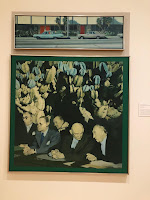What were your expectations for this course and where they met?
I wanted to learn aboutpainting, drawing, sketching, different types of art and artists. I did learn a lot about different artists from all different ages. I loved the couple drawing assignments we had. I enjoyed this class a lot. Some projects were a lot of fun! I wish there was more hands-on drawing rather than reading, watching and writing. It was very time consuming.
Now that you've been through this course, what is art? How would you define it now compared to your initial posting?
Honestly, art is what you make of it. To me, I think art is beauty. Something pleasing to the eye. I am someone who enjoys skill, symmetry, beauty, pleasing art. When I paint I do beaches, pin up girls, flowers, animals, beauty! I don’t agree with a lot of “art”. When an artist makes scribbles and lines and abstract stuff I don’t like that at all. That to me is not art. I know a friend who draws absolutely beautiful sketches of all sorts of happy, positive things that are absolutely jaw dropping because they look real, and detailed and show extreme talent. Art is beauty!
Who was your favorite artist in your original posting and who is your favorite visual artist now? If there is a difference, why do you think so? If you have the same favorite artist, why do you think so?
Now that you've been through this course, what is art? How would you define it now compared to your initial posting?
Honestly, art is what you make of it. To me, I think art is beauty. Something pleasing to the eye. I am someone who enjoys skill, symmetry, beauty, pleasing art. When I paint I do beaches, pin up girls, flowers, animals, beauty! I don’t agree with a lot of “art”. When an artist makes scribbles and lines and abstract stuff I don’t like that at all. That to me is not art. I know a friend who draws absolutely beautiful sketches of all sorts of happy, positive things that are absolutely jaw dropping because they look real, and detailed and show extreme talent. Art is beauty!
Who was your favorite artist in your original posting and who is your favorite visual artist now? If there is a difference, why do you think so? If you have the same favorite artist, why do you think so?
I don’t have a favorite artist and I never have. I enjoy all different art. There is one artist I absolutely love and I have written about him in one of my previous blogs. I don't have his name off the top pf my head, his art is at my parents house. He paints beautiful tropical images onto tiles. He uses vibrant colors and they are stunning. I will always enjoy the same kind of art I always have.
Now that you've completed this course, how do you feel about taking an online course? Is your answer the same as it was in your first posting? How is it the same or different?
I enjoy the online classes because i work a lot. Im not a huge fan of the college campus anyway, so if I can get away from it i can. I enjoy doing my work at home, or wherever life takes me! It is much more work, but it is worth it.







